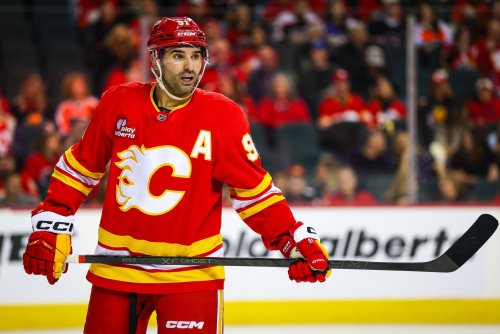
Marco Rossi was beaming. He had a goal in the first period against the Montreal Canadiens, then assisted on Brock Faber’s goal in the third period. In between, he fought 6-foot-2, 205 lbs. Kaiden Guhle. Rossi couldn’t hide his excitement when Bally’s Kevin Gorg asked him about his Gordie Howe hat trick after the game. He was still smiling ear to ear when Marc-Andre Fleury presented him with a viking helmet in the locker room.
Rossi had earned it. He’s earned everything he has now. Rossi had dropped to the Minnesota Wild at ninth overall in 2020 because of his 5-foot-9, 180 lbs. frame. He had overcome myocarditis, a COVID-19-related heart condition that threatened his life and delayed his development. A player who potentially could have debuted in his draft year played 19 NHL games early last season, registered one assist, and spent the rest of the season in the minors.
Rossi’s 53 points in the AHL in 2021-22 were an Iowa Wild franchise rookie record. The Des Moines-based team gave him a game puck after he set the record, and he looked a little less excited than when he registered his first career Gordie Howe hat trick against Montreal. He followed his record-setting season with 51 point in 53 games after his November demotion. During that time in the AHL, the St. Paul-based club lost the Central Divison race down the stretch last year, and the Dallas Stars beat them 4-2 in the playoffs.
The Wild could have used a No. 1 center last year, but they opted to put Ryan Hartman between Kirill Kaprizov and Mats Zuccarello. Ultimately, they lost in the first round for the fourth year in a row and the seventh time in eight seasons. Rossi’s development highlights Minnesota’s unique player development strategy. On the one hand, they have the No. 1 center they’ve needed since Mikko Koivu retired. On the other, they could have used Rossi for the playoffs last year.
If the Wild didn’t have the cap penalties for buying out Ryan Suter and Zach Parise, they could enact a slow-bake development strategy. They could fill their roster with league-average veterans and make any rookie who wants to make the roster force their way in. Without the need to cut costs at every turn, they could keep the veterans on short-term deals and move on from them as soon as one of their prospects takes his spot.
The upside to Minnesota’s conservative development strategy is that Rossi went from scoring one point last season to leading all rookies not named Connor Bedard in points and assists. Ultimately, their strategy paid off. The Wild got the center they needed for Kaprizov’s line. But they don’t live in a world with ample cap space and low expectations. Bill Guerin bought Parise and Suter out and wants to win now.
Minnesota is coming off back-to-back 100-point seasons, and Kaprizov’s contract is up in two years. Guerin has chosen to sign glue guys like Marcus Foligno and Hartman to long-term contracts and overpaid Alex Goligoski and Jon Merrill, freezing up the Wild’s cap space. He’s trying to establish a talent floor but has championship ambitions. The only way to go from a bubble team to a contender is to lean into upside. But Minnesota can’t do that if they can’t get their prospects out of Iowa, forcing them to play league-average veterans in high-leverage positions.
John Hynes has helped turn things around, taking over for a team that was 5-10-4 when they fired Dean Evason. The Wild are 10-3-0 under Hynes, but they have 34 points, seventh in the eight-team Central Division. The division-leading Stars and Colorado Avalanche have ten more points than them; the Winnipeg Jets have nine. Minnesota can pass the Nashville, Predators, Arizona Coyotes, and the St. Louis Blues. But they’ll have to stay hot to make the playoffs and will get a tough matchup in the playoffs if they get there.
There would be less urgency if the Wild had Kaprizov under a ten-year deal and ample cap space. Eventually, Minnesota must break its one-and-done playoff streak. But there is more urgency because Guerin played hardball with Kaprizov, and Kaprizov’s agent negotiated a contract where he could leave after the 2026-27 season. That means the Wild need to win now and must do so in the ninth circle of cap hell.
The Wild must lean on young players with upside to escape Dante’s Inferno. Foligno and Hartman aren’t going to drive winning enough for them to rise out of the eternal flames of damnation. That means they’ll need contributions from prospects like Jesper Wallstedt, Danila Yurov, and Marat Khusnutdinov before Kaprizov’s contract ends. There is no sense in bringing them up before they’re ready, but Minnesota can’t wait forever.
Minnesota bought Parise and Suter out. They signed Kaprizov to a medium-term contract and loaded up on league-average veterans. To win now, the Wild must create roster space and an environment welcoming to young players who must produce immediately. They dove deep into cap hell to rid themselves of Parise and Suter; Kaprizov is the best player ever to wear Forest Green and Iron Range red. The Wild need more prospects like Rossi to make an impact as soon as they can to keep him in Minnesota. It does no good to keep prospects who are ready in Iowa when the clock is ticking on Kaprizov’s contract.
Think you could write a story like this? Hockey Wilderness wants you to develop your voice, find an audience, and we'll pay you to do it. Just fill out this form.
-
 2
2







Recommended Comments
Join the conversation
You can post now and register later. If you have an account, sign in now to post with your account.
Note: Your post will require moderator approval before it will be visible.